Chapel Allerton
Chapel Allerton is an inner suburb of north-east Leeds, West Yorkshire, England, 2 miles (3.2 km) from the city centre.
| Chapel Allerton | |
|---|---|
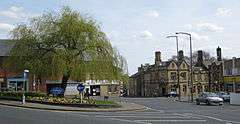 Stainbeck Corner, the effective centre | |
 Chapel Allerton  Chapel Allerton Location within West Yorkshire | |
| Population | 23,536 (Ward. 2011) |
| OS grid reference | SE303378 |
| Metropolitan borough | |
| Metropolitan county | |
| Region | |
| Country | England |
| Sovereign state | United Kingdom |
| Post town | LEEDS |
| Postcode district | LS7 |
| Dialling code | 0113 |
| Police | West Yorkshire |
| Fire | West Yorkshire |
| Ambulance | Yorkshire |
| UK Parliament | |
It sits within the Chapel Allerton ward of Leeds City Council and had a population of 18,206 and 23,536 at the 2001 and 2011 census respectively.[1][2] The area was also listed in the 2018 Sunday Times report on Best Places to Live in northern England.[3]
Location
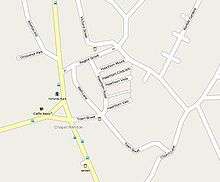
The region within the Chapel Allerton ward generally considered to be Chapel Allerton is bounded by Potternewton Lane to the south, Scott Hall Road to the west and Gledhow Valley Road to the northwest.[4]
Surrounding districts include Moortown, Meanwood, Roundhay, Gledhow, Chapeltown and Harehills. Chapel Allerton is on Harrogate Road, which, before the building of the A61 Scott Hall Road, was the main road from Leeds to Harrogate. The centre in terms of activity is Stainbeck Corner, at the junction of Stainbeck Lane, Harrogate Road and Town Street,[4] which is also the key place on 19th century maps of the village.[5]
Name
The name Chapel Allerton is first attested in the Domesday Book simply as Alreton and similarly spelled variants. It probably comes from Old English alor 'alder' (in its genitive plural form alra) and tūn 'estate, farm', thus meaning 'Alder farm'.[6][7]
The Chapel part of the name refers to a chapel associated with Kirkstall Abbey. This building was demolished in the eighteenth century; the site remains between Harrogate Road and Church Lane.[4] Already in 1240 a charter referred to land "which lies between the road which goes to the Chapel of Allerton and the bounds of Stainbeck",[8] but the name Chapel Alreton is first attested in the fourteenth century, coined to distinguish the place from the many other places called Allerton, such as the nearby Allerton Gledhow and Moor Allerton.[7][6]
The name Chapel Allerton was reduced to Chapeltown (first attested in 1427), and from this time both names co-existed and were essentially interchangeable.[5][9][7] Ralph Thoresby, writing in 1715, records Chapel-Town as a common name for the township of Chapel Allerton, describing it as "well situated in pure Air, upon a pleasant Ascent, which affords a Prospect of the Country ten or twelve miles". The open space to its east and north of Potter-Newton was "a delicate Green commonly call'd Chapel-Town Moor"."[10]
History
In medieval times, the area was mostly small farms, but by the end of the seventeenth century, it had become a resort or second home for wealthy people from Leeds[4] and in 1767 was described as the Montpellier of Yorkshire by one visitor.[5]
Chapel Allerton was incorporated into Leeds administrative area in 1869, as a civil parish. However, in 1900 it was still a village, isolated from Leeds and neighbouring Meanwood and Moortown by fields, which were gradually filled in with housing and new roads in the 20th century.[11]
Architecture
Chapel Allerton is a conservation area for the character and historical interest of its buildings, noted for a diversity of good quality domestic buildings from various periods.[4] The historic core is around Stainbeck Corner, particularly around Town Street and Well Lane, with 8 Listed buildings. To the south and west of this is an area of grand detached houses with large gardens dating from the 18th and early 19th century.[4] The earlier buildings are of fine-grained sandstone derived from the quarries which were once on Stainbeck Lane. These include a number of small 19th century two-storey houses as well as grander buildings.[4] After 1890 brick terraced and back-to-back houses were built, but of better quality than workers' housing elsewhere in Leeds, as they were intended for artisans and the lower middle class.[4] The advent of the electric tram in 1901 made the area more accessible and further housing began to fill in empty spaces [5] though this was of varied types. It finally lost its village character in the 1920s and it joined the Leeds urban area.[4] Thus the area between King George Avenue and Montreal Avenue was filled in between 1920 and 1939 with bungalows and stucco-faced houses typical of Leeds of the time.[5] In Riviera Gardens, white rendered houses were built in the Modernistic style.[5]
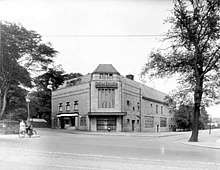
After the Second World War further building and rebuilding continued, mostly unremarkable, though with a few examples of good modern design.[5] The area was once home to an art deco cinema, the Dominion. Opened in 1934 and lasting only until 1967 when it operated as a bingo hall until the later part of the 1990, the cinema stood on Montreal Avenue. The residential street 'Dominion Close' is close to its former site.[12]
Houses
Allerton Hall was situated between Wensley Drive and Stainbeck Lane. In 1755 it was purchased by Josiah Oates, a merchant and an ancestor of Captain Laurence Edward Oates who perished in a blizzard at the age of 32 on the Terra Nova Expedition to the Antarctic led by Robert Falcon Scott in 1912.[13] A brass plaque commemorates him in Leeds Parish Church. Most of the 60 bed mansion has since been demolished. The remaining parts of Allerton Hall is a grade II listed building.[14] In the 1950s, the building was used by Twentieth Century Fox for the distribution of films across the North of England.[15] Clough House on Stainbeck Lane was converted to the Mustard Pot pub in 1979. It may date to 1653, and thus one of the oldest inhabited houses in Leeds, though most of the structure is from 1700 onwards.[16] On Wood Lane are Gothic style villas in sandstone dating from the second half of the 19th century for the middle classes.[16] Methley Place is an example of late 19th century terraces for the artisan class.[5] The Hawthorns are a set of terraces built in the early 1900s in an unusual Manorial style.[16]
 Allerton Hall from Wensley Drive
Allerton Hall from Wensley Drive Allerton Hall from Stainbeck Lane
Allerton Hall from Stainbeck Lane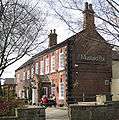 Clough House (The Mustard Pot)
Clough House (The Mustard Pot) Houses on Wood Lane
Houses on Wood Lane Methley Place
Methley Place Hawthorn terraces
Hawthorn terraces
Public buildings
On Stainbeck Corner are a pair of linked buildings, originally constructed as a police station and a fire station in 1900, now a restaurant and public library. They are a grade II listed building.[17] The style is dressed sandstone with ashlar details. The main corner doorway is flanked by Tuscan columns supporting a segmental pedimented hood containing a cartouche, and above this is a moulded and painted coat of arms of Leeds. The Harrogate Road doorways are Tudor-arched with rectangular fanlights.[16] There is a bell turret and a clock. In 1904 the fire station was converted to a public library, with some amendments to the frontage style.[16] The interior features tiled walls with 'LPL' on them, a mosaic floor in the entrance hall, stained glass in doors and ionic columns.[17] Further down Harrogate Road in the direction of Leeds is a brick and sandstone building bearing the sign "Leeds Board School 1878". This is still a school, Chapel Allerton Primary School. It is on the site of the Chapeltown Moor gallows.[16]
 Former police station (left) and library (right)
Former police station (left) and library (right) Library entrance
Library entrance Library interior with Potts of Leeds clock
Library interior with Potts of Leeds clock Leeds Board School
Leeds Board School
Inns
The public house the Nag's Head opened in 1772 as the Bay Horse Inn, a coaching inn, and according to local legend the original innkeepers were in league with 18th century highwaymen.[16] The Regent was completed in the first half of the 19th century, and its exterior is little changed from that time.[5] What is now called the Three Hulats was previously the Mexborough Arms. (The hulats are owls, of which there are three on the arms of the Earl of Mexborough[18]) The present building dates from 1911, replacing a 19th-century Mexborough Arms, a terminus for the horse tram service from Leeds, itself replacing the 17th century Bowling Green Tavern.[5] The Mustard Pot was converted from a house built in 1653 into a pub in 1979 (see 'Houses' section above).
 Nag's Head
Nag's Head The Regent
The Regent Former Mexborough Arms
Former Mexborough Arms The Mustard Pot
The Mustard Pot
Churches
The area is home to a gothic stone church, St Matthew's Church, built in 1900, the architect being George Frederick Bodley. It replaced the old church set in the churchyard on Harrogate Road. By 1935 the old church had become so unsafe it was demolished.[19] A Methodist church was built in 1877 on Town Street. It was replaced in 1983 by a smaller Methodist church and shops facing onto Harrogate Road.[20] The Methodist Sunday School opposite, built in 1878, survives as a community centre. In January 2005, Chapel Allerton Methodist Church signed a local ecumenical covenant with St. Matthew's Church.[21] Chapel Allerton Baptist Church meets on Sundays at Chapel Allerton Primary School. Originally a congregation planted from Moortown Baptist Church, Chapel Allerton Baptist Church became an independent church in 2002.[22]
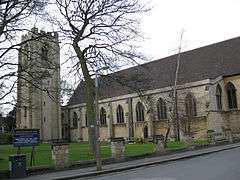 St Matthew's Church
St Matthew's Church Methodist Sunday School (now a community centre)
Methodist Sunday School (now a community centre) Current Methodist Church
Current Methodist Church
Amenities
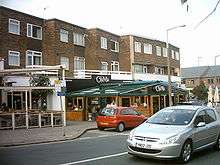
The area has an established local centre, which is situated around the junction of Stainbeck Lane and Harrogate Road. This consists of a Co-op supermarket,[23][24] a post office, several banks, several restaurants as well as many pubs and bars. There is also a large Caffe Nero.[25] More recently, a Starbucks has also been added in the former Yorkshire Bank building. There is a large Lidl store on Harrogate Road. There is also now a large Aldi, also on Harrogate Road, but more centrally located.
The former police station is now an Indian restaurant,[26] with the new police station further down Stainbeck Lane on the junction with Scott Hall Road. Originally called Chapeltown Police Station, it was renamed due to its misleading name to Stainbeck Police Station following the merger of two former divisions in 2006.[27] Officially opened on 16 November 1998, Stainbeck Police Station was the divisional headquarters for the former North East Leeds division - this division has now been absorbed into the citywide policing district but continues to be one of the many police stations in the Leeds District. The fire station was converted into a public library in 1904.[16]
There are also many takeaways, a petrol station and many other independent shops. Many cafés, bars and restaurants utilise pavement space creating a pavement café culture in the area. Some of the shops are chains, such as Greggs and Caffe Nero. There are however a significant number of thriving independent businesses, such as:
- Opposite - cafe / coffee shop
- Crust & Crumb - cafe / coffee shop
- The Woods - bar & restaurant
- Pinche Pinche - Mexican restaurant
- Hern - bistro style restaurant
- Dapur - Malaysian restaurant
- Further North - bar
Chapel Allerton has two arts centres: Inkwell Arts on Potternewton Lane and Seven Arts on Harrogate Road. Both provide concerts and community events and performances.
The Chapel Allerton Arts Festival is held the week following August Bank Holiday each year, based around Regent Street. It attracts thousands of people, assisted by volunteers from the local community. The festival offers community stalls, food and drink, arts events and a music stage that features local bands on Friday and Saturday and jazz, salsa and blues on Sunday.

Sport
Chapel Allerton Lawn Tennis and Squash Club is at the back of the square, behind the Mustard Pot pub.[28] In the 2016-2017 Squash Season, the 1st team triumphed to win the Yorkshire Squash League.
Chapel Allerton Running Club has been established since 1992. Members compete in a range of individual and team road, cross-country and fell races. There is also an annual club championship.[29]
Transport
The Leeds Tramway once ran through Chapel Allerton, but was dismantled in 1959.[30] Chapel Allerton was also once on the main road to Harrogate but the building of the A61 Scott Hall Road effectively bypassed Chapel Allerton, along with Chapeltown and Moortown. First Leeds provide the main bus service in Chapel Allerton, the 'Red Line', (No. 2, 3 and 3A). Other routes in the area include 48 to Leeds or Wigton Moor and 91 to Halton Moor or Pudsey part of the 'Leeds Overground' network of buses. The 'Red Line' links Chapel Allerton with Roundhay, Gledhow, Moortown, Chapeltown, Leeds city centre, Hunslet, Beeston, Middleton and the White Rose Centre.[31] Harrogate Bus Company also run route 36 route through Chapel Allerton, linking it with Leeds city centre (central bus station), Moortown, Alwoodley, Harewood, Pannal, Harrogate, Killinghall, Ripley and Ripon. The nearest railway station to Chapel Allerton is Headingley, from where services run to Leeds, Burley, Horsforth, Starbeck, Knaresborough, Cattal, Kirk Hammerton, Poppleton and York.
Hospital
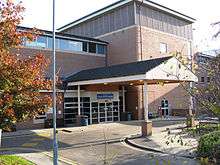
Chapel Allerton Hospital is an NHS hospital which includes the Chapel Allerton Orthopaedic Centre. It was established in 1926[32] in the building and grounds of Gledhow Grove mansion, a Grade II listed building which has now been converted to housing. The hospital now occupies buildings which were opened in 1994, across Harehills Lane from its original site.[33]
Notable people
- Margaret Scriven (1912-2001) Tennis player, born in Chapel Allerton, who won four Grand Slam titles, including back-to-back victories in the singles at the French Championships in 1933 and 1934.[34][35]
Notable references in popular culture
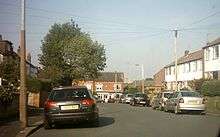
- Hill View Avenue and Norfolk Green were used as the main setting in 1980s Yorkshire Television dramas The Beiderbecke Tapes and The Beiderbecke Connection. There were also several other scenes shot in the Chapel Allerton area.[36]
- The Yorkshire Television series Fat Friends was in part filmed around Chapel Allerton, as well as in other nearby suburbs such as Kirkstall, Headingley and Moor Grange.
- The Channel 4 series Sirens was in part filmed on Victoria Street.
- The first Café Scientifique was organised by local resident Duncan Dallas in 1998 and held in In Vino Veritas in Regent Street (now Sukho Thai restaurant).
- The House of Koko was used in filming a scene in Emmerdale.
- 2013 BBC mini series The Great Train Robbery was partially filmed on Victoria Street
Location grid
References
- "Local statistics - Office for National Statistics". www.ons.gov.uk. Retrieved 11 December 2018.
- "Leeds City Ward population 2011". Neighbourhood Statistics. Office for National Statistics. Retrieved 26 February 2016.
- "Six Yorkshire postcodes appear in Sunday Times Best Places to Live guide for 2018". The Yorkshire Post. Retrieved 5 July 2018.
- "Chapel Allerton CONSERVATION AREA APPRAISAL & MANAGEMENT PLAN" (PDF). www.leeds.gov.uk. Leeds City Council. 22 October 2008. Retrieved 3 April 2019.
- R. Faulkner (1995) From Village to Suburb – A History of Chapel Allerton (Chapel Allerton Residents Association)
- A. H. Smith, The Place-Names of the West Riding of Yorkshire, English Place-Names Society, 30–37, 8 vols (Cambridge: Cambridge University Press, 1961–63), iv, 137–38.
- Harry Parkin, Your City's Place-Names: Leeds, English Place-Name Society City-Names Series, 3 (Nottingham: English Place-Names Society, 2017), p. 34.
- Holy Rosary Church Leeds Silver Jubilee 1937–1962
- William White (1853) Directory and Gazetteer of Leeds, Bradford, Halifax, Huddersfield, Wakefield and the whole of the clothing districts of the West Riding of Yorkshire (reprinted 1969 Clarke Doble & Brendon Ltd)
- Ralph Thoresby (1715) Ducatus Leodiensis: or, the topography of the ancient and populous town and parish of Leedes,and parts adjacent in the West Riding of York, pages 113, 124. A. H. Smith, The Place-Names of the West Riding of Yorkshire, English Place-Names Society, 30–37, 8 vols (Cambridge: Cambridge University Press, 1961–63), iv, 138.
- Brown, Michael; Hallett, George (1999). Noble and Spacious: St Matthew's Chapel Allerton 1900–2000. St Matthews, Chapel Allerton. pp. 124–5.
Article by Reg Simmons from the Parish Chronicle of 1950
- Department, Leeds City Engineers. "Dominion Cinema, Montreal Avenue". www.leodis.net. Retrieved 11 December 2018.
- "Leodis- A Photographic Archive of Leeds". Leodis. Retrieved 2 July 2012.
- Historic England. "Allerton Hall (1256001)". National Heritage List for England. Retrieved 14 April 2019.
- "a photographic archive of Leeds – Display". Leodis. 12 May 2010. Retrieved 5 August 2012.
- J. R. Tucker Chapel Allerton Historical and Architectural Trail (1987) Manpower Services Commission
- Historic England. "Chapel Allerton Library and Police Station (1256028)". National Heritage List for England. Retrieved 14 April 2019.
- Rotherham Web Genealogy Archived 4 March 2016 at the Wayback Machine Savile of Mexborough
- Collection, Kirk. "Old Chapel Demolition, St Matthew's Church, Postcard". www.leodis.net. Retrieved 11 December 2018.
- "Harrogate Road". www.leodis.net. Retrieved 11 December 2018.
- "Leeds North and East Circuit - Chapel Allerton". www.leedsnandemethodist.org.uk. Retrieved 11 December 2018.
- Chapel Allerton Baptist Church, accessed 25 May 2017
- Archived 23 October 2008 at the Wayback Machine
- http://findarticles.com/p/articles/mi_hb5245/is_/ai_n29376404
- "Caffe Nero – Chapel Allerton, 8 Stainbeck Lane, Chapel allerton, England, LS7 3, GB – JiWire Global Wi-Fi Finder". Jiwire.com. 21 November 2006. Archived from the original on 13 July 2011. Retrieved 5 August 2012.
- "a photographic archive of Leeds – Display". Leodis. Retrieved 5 August 2012.
- "Archived copy" (PDF). Archived from the original (PDF) on 2 February 2014. Retrieved 1 January 2009.CS1 maint: archived copy as title (link)
- Formed in 1880, it now has 16 tennis courts including 3 indoor ones and 6 squash courts. Archived 3 August 2008 at the Wayback Machine
- "Chapel Allerton Running Club". Retrieved 21 February 2015.
- "a photographic archive of Leeds – Display". Leodis. Retrieved 5 August 2012.
- "Maps | Leeds | FirstGroup plc" (PDF). Firstgroup.com. Retrieved 5 August 2012.
- "Share your secrets, share your city". SecretLeeds. Archived from the original on 12 March 2012. Retrieved 5 August 2012.
- "a photographic archive of Leeds – Display". Leodis. 31 May 1938. Retrieved 5 August 2012.
- "Peggie Scriven". The Telegraph. 12 February 2001. ISSN 0307-1235. Retrieved 10 June 2019.
- "Peggie Scriven". The Times. The Times Digital Archive. 2 February 2001. Retrieved 11 June 2019.
- Internet Movie Database with link to Beiderbecke Tapes (1987) TV series. Retrieved 1 January 2020
External links
| Wikimedia Commons has media related to Chapel Allerton. |
| Wikivoyage has a travel guide for Leeds/Chapel Allerton. |
- lovechapelallerton.com cara: Social community group and local discount scheme
- chapelallerton.org
- Chapel Allerton Conservation Area Appraisal and Management Plan
- Chapel Allerton: a short history BBC website
- chapel-a.com Community discussion forum, reviews and directory.
- YEP Chapel Allerton Community Website
- The ancient parish of Leeds: historical and genealogical information at GENUKI (Chapel Allerton was in this parish).